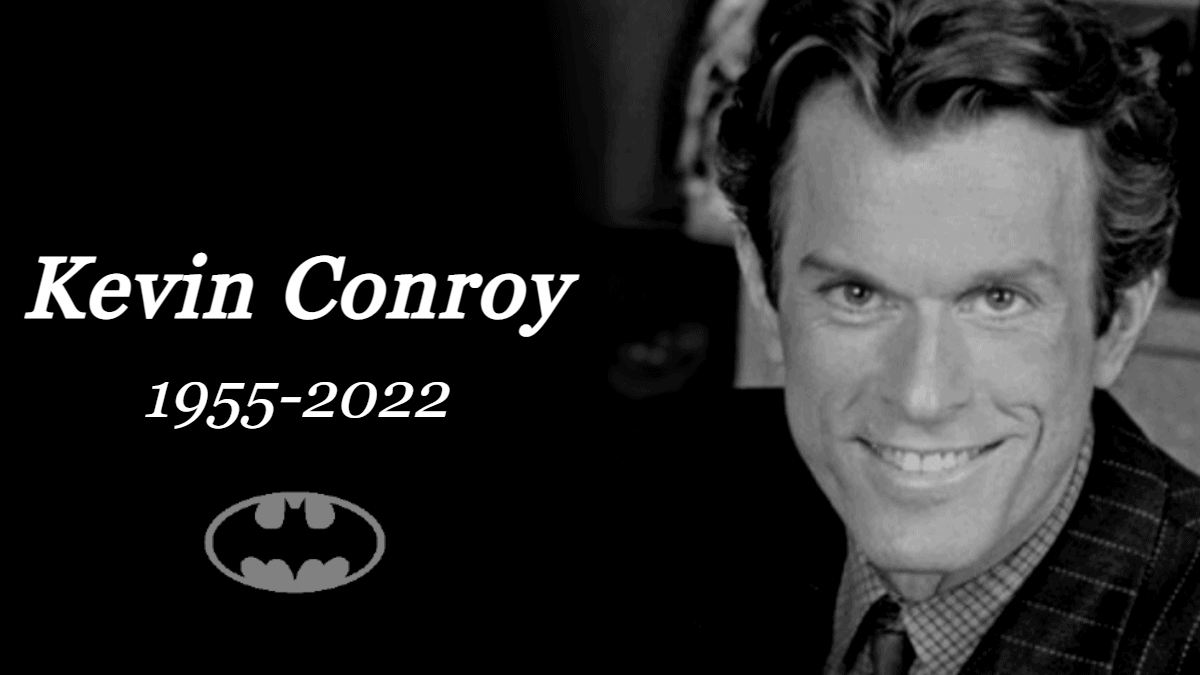DC Showcase: ‘Batman Adventures: Mad Love’ Comic Review
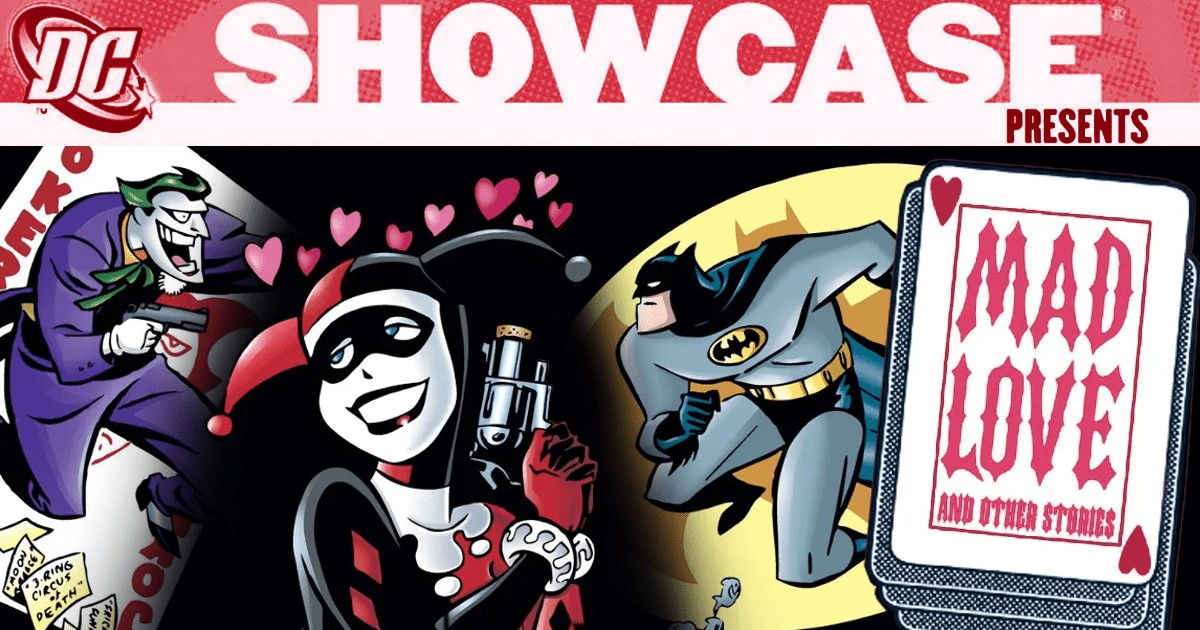
Harley Quinn is a relatively new player in the world of comicbook characters, but has quickly exploded across the world of pop culture through animation, comics, video games, and movies. But it all starts with Batman: The Animated Series creators Bruce Timm and Paul Dini, and the powerful Harley Quinn story they crafted in Batman Adventures: Mad Love.
Mad Love was the first comic to feature Harley, and it remains the most foundational. This is where, for the first time, Timm & Dini outlined the now-iconic origin story of Harley Quinn and the full depths of her relationship with the Joker. After being lauded with praise and winning both an Eisner and a Harvey Award for Best Single Issue, the two creators later adapted it in The New Batman Adventures (the final season of Batman: The Animated Series).
The complexity of Mad Love is the reason why Harley has been able to evolve so many different times over the past few decades. Timm & Dini established Harley Quinn so clearly that readers understood not only who Harley was, but also who Harley could be. With Mad Love, Timm & Dini created a singular three-dimensional comics character who has the freedom to evolve beyond their initial status quo. Her stories have taken her far from her roots as the Joker’s henchwoman. Harley Quinn can do anything in the DC Universe. And it all starts with Mad Love.
Playfully funny with a sinister layer of dark tragedy, Batman Adventures: Mad Love is the most important Harley Quinn story ever told. One of the key elements of the book is how the creators fleshed out Harley’s origin, and her toxic dynamic with the Joker. So with Joker: Folie à Deux coming soon (starring Joaquin Phoenix & Lady Gaga), let’s see how Mad Love could inspire the next version of the Joker and Harley Quinn!
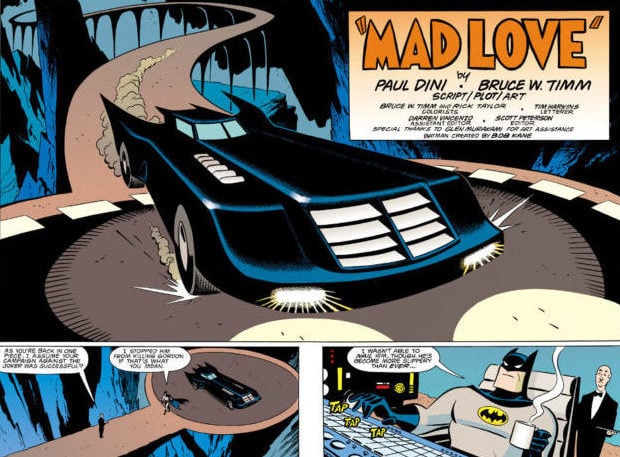
Mad Love: The story of Joker and Harley Quinn
Batman Adventures: Mad Love is one long 64-page story but it’s a breezy joy to read. The basic plot is Harley Quinn trying to take down the Batman in order to win Joker’s love. Along the way, storytellers Paul Dini and Bruce Timm present the Joker/Harley Quinn dynamic with all its flaws, and explore the path that led Harley to her current situation. Harley’s origin is so well-known by now that it’s hard to believe this was the first time her backstory was ever revealed, yet the comic still feels as fresh and timeless as ever. The greatest moments of the book are when Harley self-actualizes and challenges her dependency on Joker. This is a crucial character quality that helped her win her independence from the Joker in modern stories.
Dini’s narrative jumps between the present day and Harley’s origins. The effect becomes a bit stilted when shifting from one narrator to another, but Dini and Timm do their best to work the flashbacks into the main story in a natural way. The long-form format might benefit from chapter breaks, but Timm’s visual storytelling lends itself to natural climatic splash pages that feel like dramatic pauses themselves.
The plot falls into a few familiar tropes, but each one serves the story meaningfully. The abuse and sexual politics between Harley and Joker feel as uncomfortable as ever in 2023, but that’s the point of the book and the core impetus for Harley’s eventual liberation.
In the pages of Mad Love, the many subplots are skewed by layers of perspective from each narrator. We see Batman’s sympathy for Harley, mirrored in Harley’s sympathy for the Joker. At the same time, we also feel the pain of each protagonist through Harley’s obsession with the Joker, juxtaposed by the Joker’s obsession with Batman. Each fruitless form of love is unrequited, and the overall impression is as tragic and twisted as a true Harley Quinn book should be.
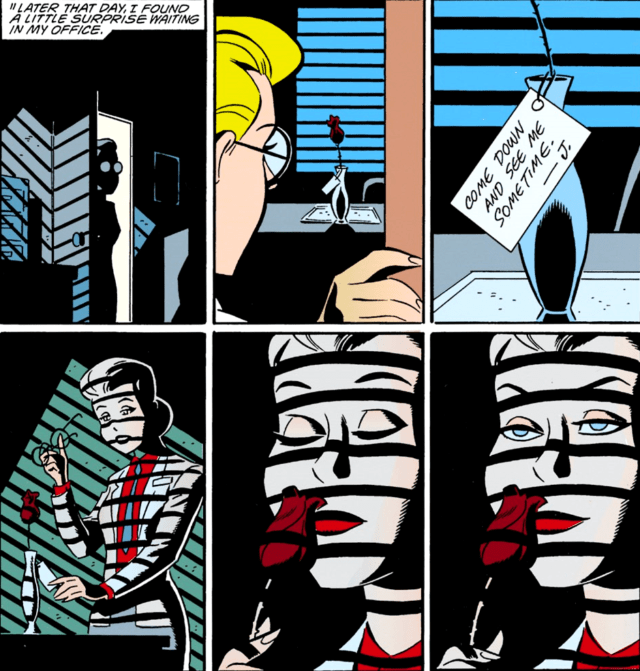
Bruce Timm’s visual style
Bruce Timm’s art in Mad Love shares the visual style of his work on Batman: The Animated Series. The shared energy between the show and the comic encourages fans to add their own sound effects, music, and voicework as they’re reading the story. With unforgettable performances by Kevin Conroy, Mark Hamill, and Tara Strong, and music by Shirley Walker, being familiar with Batman: The Animated Series greatly enhanced my reading experience.
But Timm takes his skills a step further too. His work in Mad Love fully embraces the comics medium with loving touches of Jack Kirby, Dr. Seuss, and the classic 9-panel grid of Watchmen. One of my favorite references is how closely Timm’s Joker resembles Conrad Veidt’s signature look from The Man Who Laughs, the 1928 film which inspired the original Joker design.
Across the book, the characters’ poses and expressions are wonderfully cartoony, highlighted by bombastic sound effects, hilarious background gags, and coloring that’s as silly and moody as the story itself. Entire sequences are told silently through the power of Timm’s images and Tim Harken’s playful lettering. More than just animation storyboards, the visual style of Mad Love is the soul of the story. Every panel overflows with the creators’ love for the characters and the comics medium itself.
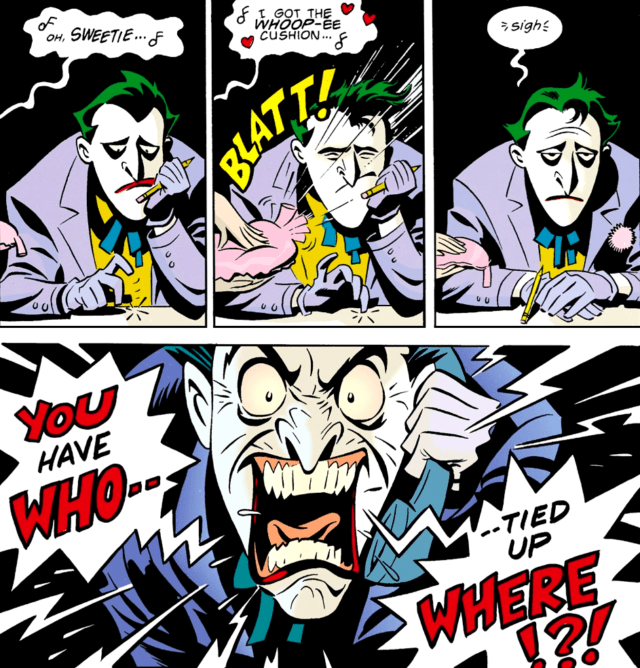
Mad Love is the perfect first comic for Harley Quinn fans
No prior reading is needed before starting Mad Love, and it is the perfect place to start for new fans. If you like to read physically, I personally recommend the 2009 edition called Mad Love and Other Stories. This includes Rick Taylor’s original coloring and additional stories from Bruce Timm and Paul Dini based on their Batman: The Animated Series universe.
There is also a 2015 Mad Love: Deluxe Edition, which includes Bruce Timm’s behind-the-scenes artwork for each page, but excludes the extra stories from the 2009 edition. The Deluxe Edition was also recolored to be more realistic with stronger shadows. While the realism takes away the cartoony simplicity of the first edition, the deluxe coloring matches Timm’s original intentions for the more dramatic art style of the book.
- Mad Love and Other Stories (2009 edition)
- Batman Adventures: Mad Love (simple coloring)
- Batman Adventures Annual #1:
- “Going Straight”
- “Puppet Show”
- “24 Hours”
- “Study Hall”
- “Laughter After Midnight”
- Adventures in the DC Universe #3: “Cruise To Nightmare”
- Batman Adventures Holiday Special #1: “Jolly Ol’ St. Nicholas”
- Batman Adventures Annual #2: “Demons”
- Batman: Black and White #1: “Two of a Kind”
- Mad Love: Deluxe Edition (2015 edition)
- Batman Adventures: Mad Love (realistic coloring)
- Batman Adventures: Mad Love (reprinted with Bruce Timm’s original artwork, sketches, and notes for each page)
Dini and Pat Cadigan also adapted Mad Love into the prose novel Harley Quinn: Mad Love, which includes new elements from later comic storylines to create a deeper Harley Quinn experience. For more comics recommendations, Dini continued writing Harley in Gotham City Sirens. The beloved series teamed-up Harley, Ivy, and Catwoman, and fleshed out Harley’s family history. And most recently, Stjepan Šejić wrote and drew the highly acclaimed Harleen miniseries, which serves as a mature, modern retelling of Mad Love.
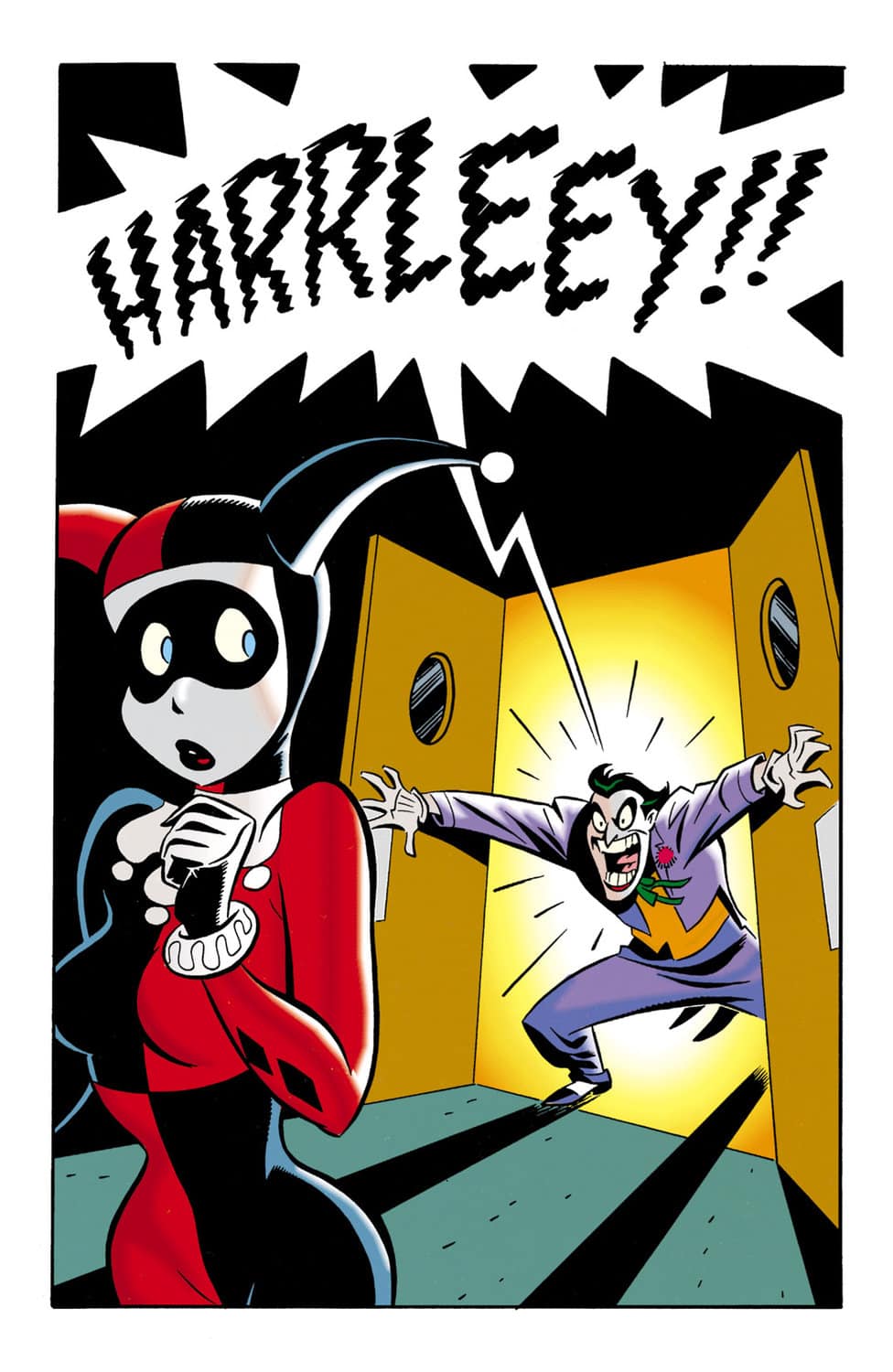
Mad Love: Harley Quinn on screen
If you’re totally new to the animated universe, then I recommend watching a few of Harley’s episodes in Batman: The Animated Series to be familiar with the voices, music, and style of the show before starting Mad Love. After reading, I especially recommend watching the “Mad Love” episode to see how Bruce Timm and Paul Dini adapted their comic into actual cartoon form.
- Harley Quinn’s best episodes in Batman: The Animated Series (Production order)
- S1 E22: “Joker’s Favor” (first appearance)
- S1 E34: “The Laughing Fish”
- S1 E51: “The Man Who Killed Batman”
- S1 E56: “Harley and Ivy” (leaves Joker, meets Poison Ivy)
-
- S2 E03: “Trial”
- S2 E07: “Harlequinade” (teams up with Batman against Joker)
- S2 E16: “Harley’s Holiday” (goes clean, debuts roller skates)
-
- S3 E01: “Holiday Knights” (living with Poison Ivy)
- S3 E07: “Joker’s Millions”
- S3 E20: “Girls’ Night Out”
- S3 E21: “Mad Love” (Harley’s origin story)
- S3 E23: “Beware the Creeper” (a new ‘Joker’ pursues Harley)
Joker: Folie à Deux will surely adapt the definitive elements from Mad Love, namely Dr. Harleen Quinzel starting as Joker’s psychiatrist and their consequent toxic relationship. However, given the loose freedom of the first film, this might be the full extent of the comics inspiration for the movie. Considering how important Batman is to their broken relationship in Mad Love, it will be interesting to see how the Harley/Joker dynamic plays out in a universe without a Batman.
Beyond Joker: Folie à Deux, there are some sequences in Mad Love that have already transcended into other mediums. Of course, Margot Robbie’s Harley Quinn in the DCEU has taken heavy inspiration from Mad Love and the original Batman: The Animated Series version of Harley. One of my favorite examples is a playful prison breakout in Mad Love, which feels like the predecessor to Robbie’s similar breakout scenes in Cathy Yan’s Birds of Prey and James Gunn’s The Suicide Squad. Even the mercurial Joker backstory in Mad Love plays on elements from Alan Moore’s The Killing Joke and foreshadows Heath Ledger’s interpretation in The Dark Knight.
The only 1:1 Mad Love adaptation was done in Batman: The Animated Series. But the essence of the book has informed every portrayal of Harley Quinn ever since. The Arkham Asylum games, the DCEU films, the Harley Quinn animated series, and the decades of comics – there is no interpretation of Harley Quinn that doesn’t start with Mad Love. This is her character bible.

My verdict on Mad Love
Batman Adventures: Mad Love feels long at 64-pages but this wacky, fun, and deceptively simple story contains enough complexity to inspire decades of Harley Quinn arcs. The Killing Joke of Harley Quinn stories, Mad Love’s standalone, alternate-universe tale tells you everything you ever needed to know about Dr. Harleen Quinzel and her relationship with Joker. The focus on Batman also gives the dynamic an interesting third wheel, which Paul Dini and Bruce Timm use to examine his impact on both Joker and Harley Quinn. If you’ve fallen in love with any of the countless multimedia adaptations of Harley Quinn, then Mad Love is the ultimate comic recommendation for you.
What’s your favorite version of Harley Quinn? Are you excited to see Lady Gaga’s Harley in Joker: Folie à Deux? Let me know on Twitter @vinwriteswords and remember to follow the site @MyCosmicCircus for more comics coverage coming soon!
Check out our full list of DC comic reviews here, plus our review of Harley Quinn: A Very Problematic Valentine’s Day Special!
And if you love Batman: the Animated Series, be sure to read our moving tribute to Kevin Conroy, who will forever be the voice of Batman.


